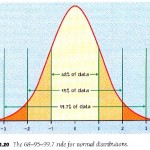October 2nd, 2008 by Frank LaBanca, Ed.D.
 Last week I taught a statistics class on converting data to different forms: z scores, percentile rank, NCE scores, and the like. The challenge with teaching these concepts, besides the obvious mathematical concerns, is the relevance of doing it. The basic meaning behind converting scores is to put numbers in common terms so sets of data can be related to one another. For example if one instrument had potential scores of 1-42, and another had a range from 200-800 (like the old math SAT ranges), its hard to put that interval-level data into common terms. That’s the ultimate purpose of the z-score: to base a set of data (e.g., a sample of students with normal distribution with a specific standard deviation), in common terms, regardless of the raw score format. Remember that z-scores are based on a SET OF DATA that is inter-related.
Last week I taught a statistics class on converting data to different forms: z scores, percentile rank, NCE scores, and the like. The challenge with teaching these concepts, besides the obvious mathematical concerns, is the relevance of doing it. The basic meaning behind converting scores is to put numbers in common terms so sets of data can be related to one another. For example if one instrument had potential scores of 1-42, and another had a range from 200-800 (like the old math SAT ranges), its hard to put that interval-level data into common terms. That’s the ultimate purpose of the z-score: to base a set of data (e.g., a sample of students with normal distribution with a specific standard deviation), in common terms, regardless of the raw score format. Remember that z-scores are based on a SET OF DATA that is inter-related.
The majority (~96%) of z-score data will be between the values of -2 and 2, with a mean of 0. Uggg . . . now all numbers are on the same scale, but still have relatively little meaning to a non-stats person. So the percentile rank comes in. Put the scores in percentiles relative to one another. This comes at a cost: the data is now ordinal. But the benefits are enormous: they have meaning to practitioners.
 Now for an affective comment. I went home with a sore throat. Hmmm . . . I must have been talking too much. I wonder, for a two-hour class session, if there was too much direct instruction. Were there enough opportunities for the students to apply their knowledge?
Now for an affective comment. I went home with a sore throat. Hmmm . . . I must have been talking too much. I wonder, for a two-hour class session, if there was too much direct instruction. Were there enough opportunities for the students to apply their knowledge?
I pondered this on the drive home, and even more so on Friday, when I had the opportunity to meet with a master World Language teacher for whom I am serving as a dissertation major advisor. Since my primary role is a science teacher, I wanted to expose myself to the instructional experiences of a high school Spanish teacher. For me, this was a wonderful and enlightening experience.
I had never seen a computer-driven language lab and the power of allowing students to demonstrate their technical speaking, reading, and listening skills. The process was so fluid and dynamic, and the transitions from learning activity to learning activity were masterfully administered. No doubt, this was due to an extraordinary master teacher. Easily five different learning activities took place in each class I observed. Each learning activity was targeted to a specific skill or knowledge and was seamlessly transitioned to the next. Just amazing to watch, and I know I do it no justice in words.
My learning helps to remind me that students need a variety of instructional strategies to address their varied learning styles. Also it reinforces my general strategy to vary instruction, especially in an extended-class setting.